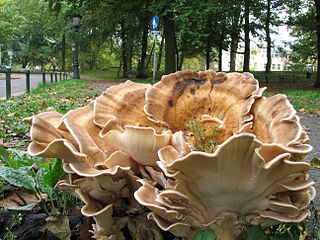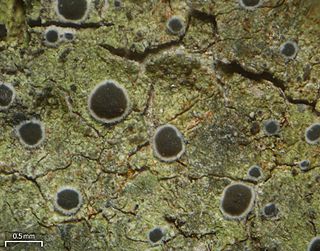
The Russulales are an order of the Agaricomycetes,. According to the Dictionary of the Fungi, the order consists of 12 families, 80 genera, and 1767 species. According to Species Fungorum, the order contains 13 families, 117 genera, and 3,060 species.

The Hypocreales are an order of fungi within the class Sordariomycetes. In 2008, it was estimated that it contained some 237 genera, and 2647 species in seven families. Since then, a considerable number of further taxa have been identified, including an additional family, the Stachybotryaceae. Wijayawardene et al. in 2020 added more families and genera to the order. According to the Catalog of Life, As of April 2021 the Hypocreales contains 6 families, 137 genera, and 1411 species. Hyde et al. (2020a) listed 14 families under Hypocreales, while, Wijayawardene et al. (2022) accepted 15 families in the order, where Cylindriaceae was additionally added. Earlier, Hyde et al. (2020a) had placed Cylindriaceae in class Xylariomycetidae. Samarakoon et al. (2022) agreed. Hence, Cylindriaceae should have been excluded from Hypocreales and placed in Xylariomycetidae. Xiao et al. (2022) recently introduced a new family Polycephalomycetaceae to Hypocreales.

The Saccharomycetaceae are a family of yeasts in the order Saccharomycetales that reproduce by budding. Species in the family have a cosmopolitan distribution, and are present in a wide variety of habitats, especially those with a plentiful supply of carbohydrate sources. The family contains the species Saccharomyces cerevisiae, perhaps the most economically important fungus.

Gomphus is a genus of cantharelloid fungi in the family Gomphaceae. Once presumed to be related to chanterelles, molecular study has shown them to be allied with stinkhorns and fairy clubs. The type species of the genus is the pig's ear (G. clavatus).

The Ganodermataceae are a family of fungi in the order Polyporales. As of April 2018, Index Fungorum accepts 8 genera and 300 species in the family. The family was circumscribed by Dutch mycologist Marinus Anton Donk in 1948 to contain polypores with a double spore wall. The inner wall is verruculose to ornamented, thickened and usually coloured, while the outer wall is thin and hyaline.

The Meripilaceae are a family of fungi in the order Polyporales. The family was circumscribed by Swiss mycologist Walter Jülich in 1982 with Meripilus as the type genus. A 2008 estimate placed 7 genera and 57 species in Meripilaceae. As of April 2018, Index Fungorum accepts 74 species in the family.
Biatorellaceae is a family of lichen-forming fungi in the subclass Lecanoromycetidae. The family is monotypic, and contains the single genus Biatorella, which contains eight species.

The Pilocarpaceae are a family of crustose lichens in the order Lecanorales. The species of this family have a cosmopolitan distribution and have been found in a variety of climatic regions. Pilocarpaceae was circumscribed by Alexander Zahlbruckner in Adolf Engler's influential 1905 work Die Natürlichen Pflanzenfamilien.

The Stereocaulaceae are a family of lichen-forming fungi in the order Lecanorales. It contains five genera. Species of this family are widely distributed in temperate boreal and austral regions.
Ceriosporopsis is a genus of fungi in the family Halosphaeriaceae. The genus contained seven species in 2008, and 8 species in 2023.
Saagaromyces is a genus of fungi in the family Halosphaeriaceae. The genus contained three species in 2008, and 4 species in 2023.

Retiboletus is a genus of fungi in the family Boletaceae. The genus, first described in 2002, contained six species distributed in north temperate regions.

Hanseniaspora is a genus of yeasts. The name Kloeckera is applied to its anamorph form. They are typically apiculate (lemon-shaped) in shape and often found in grape musts pre-fermentation.

Haematomma is a genus of crustose lichens established by Abramo Bartolommeo Massalongo in 1852. It is the sole genus in the Haematommataceae, a family circumscribed by Josef Hafellner in 1984. Commonly called bloodstain lichens, the species assigned to this genus are widely distributed in tropical and temperate areas.
Hanseniaspora gamundiae is a species of yeast in the family Saccharomycodaceae. It has been isolated from the fruiting bodies of Cyttaria hariotii mushrooms in Patagonia and is likely responsible for the early stages of fermentation of an alcoholic chicha produced from the mushrooms.
Austrocortinarius is a genus of fungi in the family Cortinariaceae.

Cystinarius is a genus of fungi in the family Cortinariaceae.

Hygronarius is a genus of fungi in the family Cortinariaceae.
Mystinarius is a genus of fungi in the family Cortinariaceae.

Volvanarius is a genus of fungi in the family Cortinariaceae.














